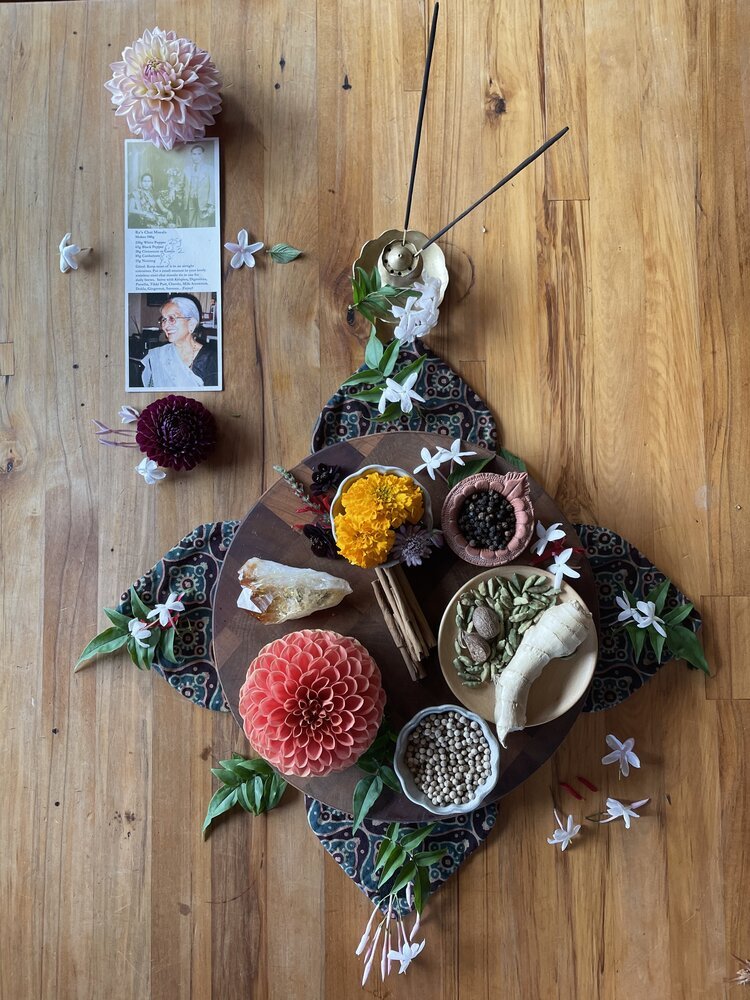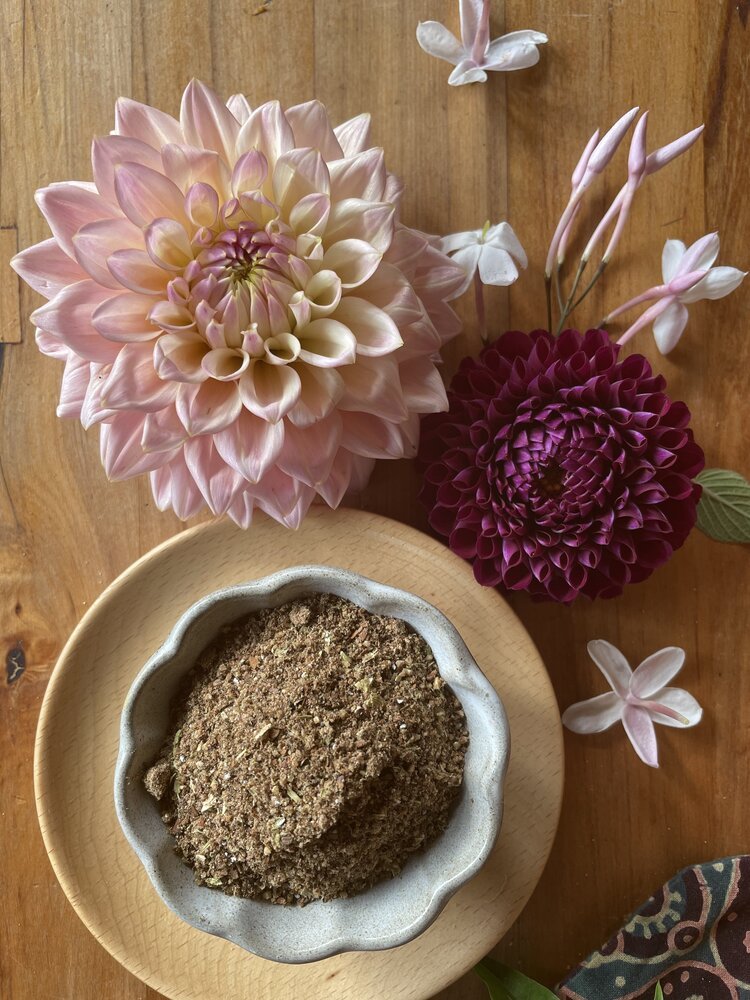Grandmother’s Love, Chai and a Diaspora Story
I was feeling way too tender in my heart to share this at my Grandmothers passing last year during lockdown, but April 1st 2021 would have been my Grandmothers 100th birthday so it feels like the right time to honour such a beauty.
My Grandma, Laxsmiben Ravjibhai Mistry lived with us from when I was 4 onwards. We called her Ba, meaning mother in Gujarati. We had just emigrated to New Zealand from the UK in 1983 when my grandfather died so she came and joined us in Waiuku, rural south Auckland. Ba was the reining matriarch of our family and a particularly magical and sparky woman. She had seriously incredible super powers of calm, patience and unconditional love that my three siblings and her 36 other grandchildren and I are so lucky to have experienced.
Ba did not speak a word of English and was a boss at homestyle Gujarati cookery. She always cooked with the most important nutrient of all - Vitamin L (LOVE). Because my mum and dad worked solid 12 and 16h days all year round in the supermarket (dad was also the baker), Ba did all of the cooking and my siblings and I were her right hand assistants. She would tell us to stir, pour, add more of this, more of that, chop that finely, and the best one of all, how does it taste? Ba would have us sitting there with a tiny hand cranked grinder in which we would grind chillies, garlic and ginger. For bulk masala mixes, she would have us doing shifts using the tiny coffee mill grinding kilograms of garam and chai masala. It was pretty exciting when we discovered professional grade coffee grinders in the 2000’s which definitely streamlined masala production (masala is a blend of spices).
When I think about her life, she was a powerhouse with immense purpose. She had six children, four daughters and two sons who are now based in different countries. Ba played an active part in the lives of so many of her grandchildren. She took care of my two younger sisters, myself and my baby brother who was born when she was 75 years old. She cooked most of the family meals until she was 90 years old, at which time, finally, my mum was allowed to take over.
Ba, like all of her peers was an incredible cook. You had to be, as protein was so scarce, you needed to to make the most use of what little you had. She grew up in a tiny village called Sagra, tending a small family farm with her mother on the west coast of Gujarat. The meals she prepared were made in the style of the regional cuisine of coastal Gujarat, taught to her by her mother.
My mum, Ba and me celebrating my third birthday
Ba was born in 1921. During India’s fight for freedom she and many thousands of individuals and families took part in the 240km Great Salt March from Ahmedabad to Dandi on the Arabian Sea Coast led by Mohandas Gandhi from March to April 1930. This was an act of civil disobedience to protest against British rule and the tax that every Indian had to pay to the British each time they collected salt. As a nine year old, Ba, her mother and fellow villagers marched and carried as much rock salt as they could to Dandi beach.
Ba had so many epic bedtime stories. She and I shared a bedroom so I was lucky to hear lots of them especially her childhood stories. Like when she was bitten by a scorpion and the kids from her village had to run all the way to a neighbouring village to get help. I loved hearing all of her stories, all the different lives she led and the places she lived during her ninety nine years on earth.
95th Birthday Afternoon Chai Party
She, like so many, including my parents had an arranged marriage. She married my Grandfather, a builder from a neighbouring village called Kadiawad, near Navsari, Gujarat. Following work, they moved to Uganda and then to Eldoret in Kenya where they settled for around 15 years and raised six children, the second of which was my father, Mohan.
When Kenya gained independence, the family returned to India with little money. At that point, Mohan, who was the eldest boy (14yo), would leave India and move to England to seek work and study at night, with his 8 year old brother (Subhas) in tow. His earnings would help the family. They lived and worked with people from their village who were working in the textile mills in Bolton, Lancashire near Manchester. The girls of the family (Mani, Indu, Ila and Parvati) would marry and move to faraway lands: Uganda, New Zealand, London and Kenya.
Ceremony, gods, goddesses, religious festivals, fasting and feasts involving elaborate food preparation signify Indian culture. Because Ba shared these practices with us, we were regularly able to participate in all of the preparation and ritual. I feel that sharing this with us and her extended family gave her an incredible sense of purpose. This was her way of gifting us a huge piece of history. These are the gifts that live within us that need to be shared in our communities.
Ba passed on Earth Day (April 22nd 2020), during our New Zealand Covid 19 pandemic lockdown level 4 on the most perfectly still sunny day (the cause was not Covid). She had just turned 99 on the 1st of April.
Following her passing and at her funeral there were so many stories about food and chai and the wonderful delights the family grew up eating over the different eras and dipping into a mug of freshly brewed gingery chai.
Ba’s Chai Masala
Ba, like everyones Indian Grandma, was highly committed to chai brewery, She would make a spicy, gingery brew three times a day for the house and also fill a thermos to take to my parents and staff at the supermarket. Us kids were on the chai probably from 6 months (um, don’t do this to your baby!). Definitely not ideal for iron absorption but I’m pretty sure I loved it. (Ba used to make a big batch in bulk - I divided her recipe by 10, so feel free to upscale even to double).
Chai Masala Ingredients:
25g White Pepper
7.5g Black Pepper
2.5g Cinnamon or Cassia bark
10g Cardamom
2.5g Nutmeg
Lightly roast spices in a heavy bottomed pan, cool & grind in a spice grinder or a mortar and pestle. Store in an airtight container to use in your daily brews.
Brewing your Chai:
3C Water
2Tbsp Black Tea
1/4 Tsp Chai Masala
1 -2 Tsp Grated Ginger (Lemongrass and Mint are traditional too)
Bring water to the boil, add milk (this depends what type of milk you use. If you use cows milk then bring this to the boil as well and then strain.
If using plant based milk, you may want to experiment with how much you want to heat the chai once you have added milk. I don’t heat it too much.
Note: A mortar and pestle is a very special way to grind spices as it involves so many senses: the smell with its astonishingly beautiful aroma , movement and rhythm, the sound, beats the grinder in lots of ways. The mortar and pestle is really nice for kids to experience too (don’t fill the mortar and pestle too much for them or it could get messy). However, the grinder creates a really consistent grind so it’s a personal choice. You could begin with the mortar and pestle and finish it off in the grinder or leave it bigger. The taste is the same and with loose leave tea you will need a strainer anyway.
This is a reasonably peppery brew, its really good with ginger but you might like other spices to pop more such as the cardamom or cinnamon. Or you might want to add fennel, just add more of your favourite spices. You could add less pepper and use Horopito leaves which taste very peppery instead.
In terms of snacks to have with chai, spice on spice is hard to beat. Here are some Gujarati classics that are great with a chai: Samosa, Tikki Puri, Paratha, Dhokla, Chevdo, Handvo, Patra, Pakora…There is a great scene in one of my favourite movies, the Namesake where Ashima adds cayenne pepper and peanuts to a bag of cornflakes. That scene captures so much of late 1970’s Indian immigrant life.




